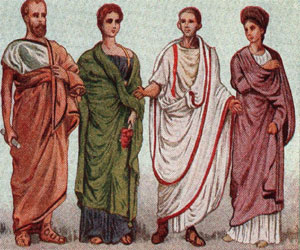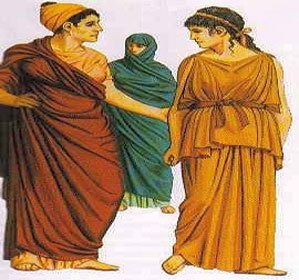History Of Clothing
DIGITAL ART - FASHION - LIFESTYLE
Published On: June 21, 2014
History of Wearing Clothes
Covering and making others cover has been the agenda on which humans have been working since their existence and that covering cladding human skin is a piece of cloth .
Wearing clothes is a feature of humans only among the other species of animals. There is no definite proof as how old is the history of wearing clothes or when was the first cloth made or what was the first cloth called? However anthropologist suggested that humans have been using this method of covering as a protection from climate change, to cater their skin from dusty winds and sandy storms, from snowy squall and freezing temperatures, from rain and humid atmosphere making clothes of different materials soft and thick material that perfectly suits the current atmospheric condition
From the use for protection purposes, man has used clothes as a covering material for decoration, magic , artistic or religious demonition. With the progress and better living statuses, different cultures were introduced, each describing new way of cladding one body. Slowly and gradually a specific set of clothes got the social significance and became an emblem of the respective culture.
Textile
Textile basically is the process of making clothes from fibres that are processed and are shaped into the output of cloth-the material which we wear. Textiles industries have created revolutionary
designs in clothing, creating an inspirational touch to the fabric.
History of Textile
The history of textile is as old as 20th century. However it is quoted that Solutrean culture that existed in France dated back in 19000 BC give hints of sewing needles. The weaving history evolves from Czech Republic inhabitants. The first method used for textile was “felt”. It is a process of matting, condensing and compressing fibres to shape it into a cloth piece. “Nalbinding” is also a technique to make fabric by knitting. In English it is famous by the name of KNOTLESS KNITTING, as it was done by one needle. This method was used widely in ancient times nevertheless is quite famous among countries like Peru, Scandinavian states and Balkan. Then loop was developed to weave clothes .Dated 6000 BC the first woven cloth was made to cover the dead in NEAR EAST.
Other civilizations like Indus valley occupants, their speciality was fabric made of cotton, worn by people of ancient Egypt and chins, the cloth material gained wide popularity among Mid East countries. In 1st century Arabs brought this trend to Spain and Italy which was further followed by cultivation of cotton in Spain during 9th century .It was transported to England before fifteenth century, then East India Company imported rare cloth materials from India.
Early History of Clothing
Egypt showed linen influence from 5500 BC. They also cultivated flax for the purpose of making clothes. Fibres like rush, reed, palm and papyrus were mixed with lined to make ropes spinning techniques and a vertical two bloom were introduced in Egypt from Asia. Linen bandages were draped around mummies in their process of burial and preservance.
History of skill grasped its roots from China in Yangshao culture back in 5000 and 3000 BC.Shang Dynasty introduced Hanfu to the Chinese people. It is still used by Han Chinese populations. Silk fabric gained wide popularity among elite. They had worn vivid and vibrant colour clothes.
The first evidence of spinning in Thailand can be found at the place of The Kaeth located in Central Thailand Here, prehistorians discovered 90 fragments of spindle whorl from third century BC to third century AD. The dimensions and shape of spin were very similar to India and south china. A spindle whorl is a disc or spherical object that fits onto the spindle to increase as well as maintain the speed of spinning.
The textile road in the ancient time was the famous Silk Road connecting the East to the West. It was a centre for cultural and social development. Traders, merchants and nomads used to cross that way to get connected to the two opposite directions on the earth latitude.
Greece and Rome set their times wearing unwoven and unsown clothes, simply draping their bodies. Ancient Greece clothing comprises of lengthy pieces of linen which were rectangular in shape and were secured at the shoulders with adorned pins and belted with a sash. Women used to wear a loose robe called peplos and the chlamys a cloak worn by men; and the chiton, a tunic worn by both men and women. Men’s chitons hung to the knees, whereas women’s chitons fell to their ankles. A long cloak called a himation was worn over the peplos or chlamys.
The toga of ancient Rome was also not sewn worn by Romans over a simple tunic. Early tunics were two simple rectangles joined at the shoulders and sides; later tunics had sewn sleeves. Women wore the draped stola or an ankle-length tunic, with a palla as an outer garment. Wool was the preferred fabric, although linen, hemp and small amounts of expensive imported silk and cotton were also worn.
20 & 21 Century Varieties
In mediaeval Europe, renaissance period and modern Europe various varieties of clothing has been developed with various garments clad by the elites and high class officials. The 20th century proved to be a revolution in the history of clothing and now on the threshold of 21st century the industry of clothing has emerged as a big expansive industry .With modern machines like water wheels and steam engines , the process of clothing has become super easy . The production which was started in the cottage turned into a sophisticated mass organization making assembly of effective streamlining clothing production.


















